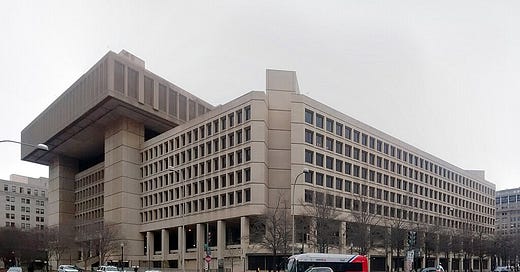Brutalism is Bad for the Soul. Return to Traditional Architecture.
Washington D.C. looks much more like Stalin's Moscow than Caesar's Rome. Most of that has to do with the ugly Brutalist buildings.
Washington D.C. is a city known for many good things. An abundance of free museums, beautiful cherry blossoms, and damn good bowls of chili. Unfortunately, it’s also known for a myriad of horribly ugly Brutalist style buildings that marr the city’s landscape.
Brutalism and its unsightly progeny throughout the District of Columbia are the highlight of a new exhibit at the National Building Museum, giving visitors a taste of some of the most hideous works of architecture to blight humanity’s eyes.
Defined by its stark concrete edifices, Brutalism became the preferred architectural style of Washington’s urban planners in the 60s and 70s as part of a plan to renew the district’s crumbling infrastructure.
In its 1962 Guiding Principles for Federal Architecture, the Government Services Administration emphasized that
The design of Federal office buildings, particularly those to be located in the nation’s capital, must meet a two-fold requirement. First, it must provide efficient and economical facilities for the use of Government agencies. Second, it must provide visual testimony to the dignity, enterprise, vigor, and stability of the American Government.
That push for “efficiency” and “stability” at the expense of human elements showed in the buildings.
The Department of Energy’s James V. Forrestal Building, the J. Edgar Hoover Building housing the FBI, even the underground Metro system all were made in the “economical” Brutalist style.
The results were government buildings that oozed an oppressive atmosphere, evoking more the Soviet Union than the heart of the free world. That sense of overwhelming repression is not imagined as in a very real sense the architecture is damaging to the human spirit.
Brutalism and its ilk were incredibly popular with communist and socialist architects who used the style to crush any ideas of individuality or humanity. Constructivist architecture, Brutalism’s Ruskie cousin, fit perfectly with the Soviet Premier Joseph Stalin’s desire to create a totalitarian police state bereft of liberty. The very buildings themselves served as aids in repressing the humanity of the Soviet people, an omnipresent reminder of the iron fist of the state.
Notice any similarities between the FBI headquarters and the (since demolished) House of the Soviets in Kaliningrad? One would be forgiven if they assumed the same architect had constructed the pair to glorify Mother Russia.
Indeed, modern American leftists have noted that the Brutalist buildings came from a time “when our country invested in the civic realm, when government could be a positive caretaker of its most vulnerable people.” As if the time where the government was morphing into the bloated administrative state we have today should be celebrated.
But thankfully America is not the Soviet Union, and there have been efforts to stymie the construction of new Brutalist buildings. In the twilight days of his administration, President Trump issued an executive order encouraging the construction of “beautiful” federal architecture.
“New Federal building designs should, like America’s beloved landmark buildings, uplift and beautify public spaces, inspire the human spirit, ennoble the United States, command respect from the general public, and, as appropriate, respect the architectural heritage of a region,” the order read.
The order encouraged architects to use classical and traditional styles of architecture, of which the district has many. The Supreme Court, the Capitol, the White House, all stunning testaments to the glory of the American republic in resplendent marble. This was to be the model for a new age of American infrastructure.
While the order went nowhere with Biden taking the reigns, there is still potential for Congress to act. During this session of Congress, Indiana Republican Jim Banks introduced the Beautifying Federal Civic Architecture Act to establish a President's Council on Improving Federal Civic Architecture and essentially codify Trump’s executive order into law.
It’s a great idea, and one that I hope to see enacted soon. Architecture should uplift the human spirit and push us to strive for ever greater heights.
Briefly returning to Europe, though closer to Washington D.C. than Moscow, consider French author Victor Hugo. He believed architecture was essential to France’s identity and wrote Notre Dame de Paris (in English, The Hunchback of Notre Dame) as a love letter to the Parisian cathedral.
Hugo saw the beauty of the building as a mark of French excellence, and that the cathedral had fallen into disrepair as a black mark on the nation’s character that had to be rectified immediately. It worked.
So too should America look at our capital’s architectural landscape and be ashamed. To the bin with Brutalism. For the sake of the human spirit, we must renew the classics.



